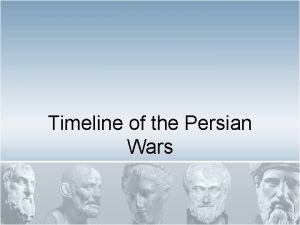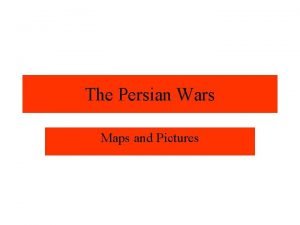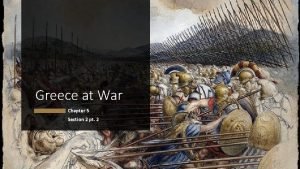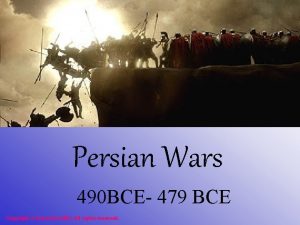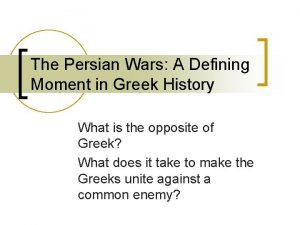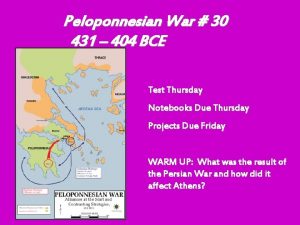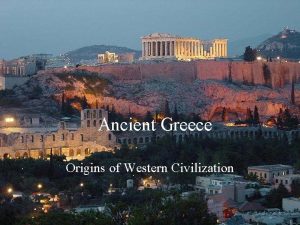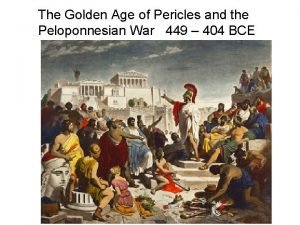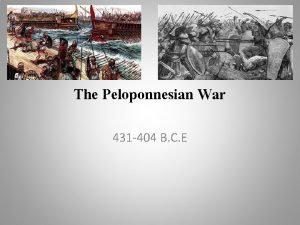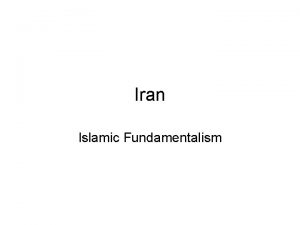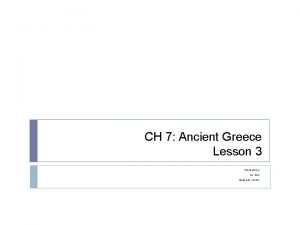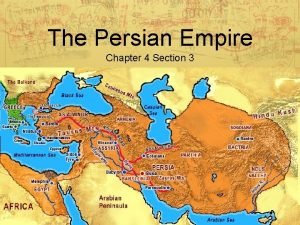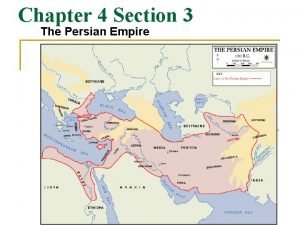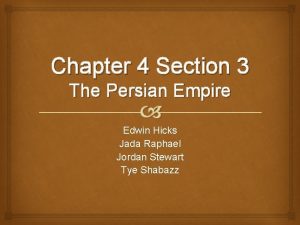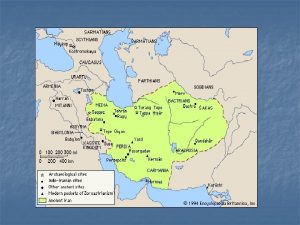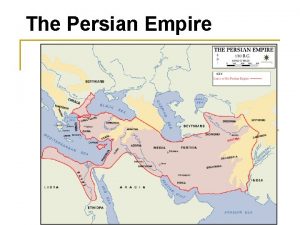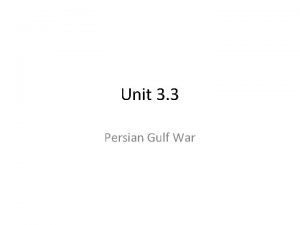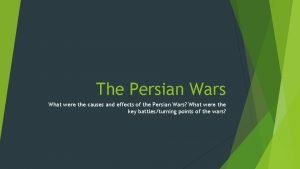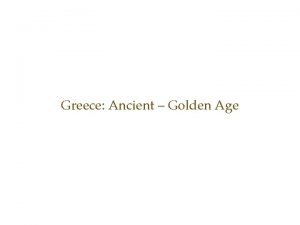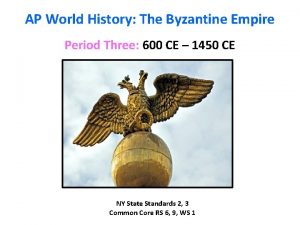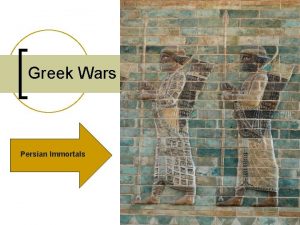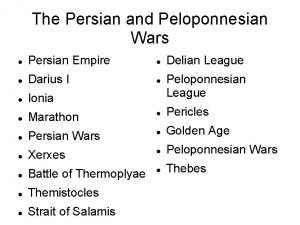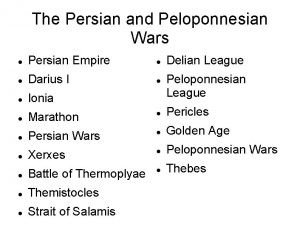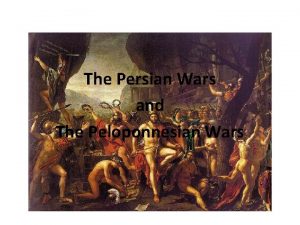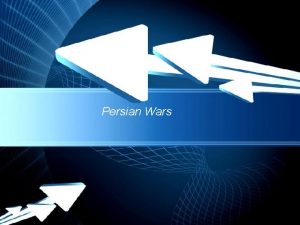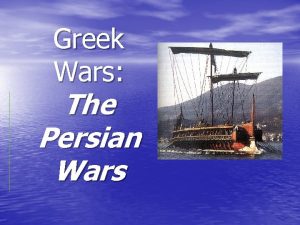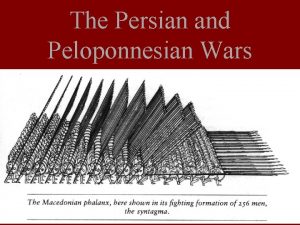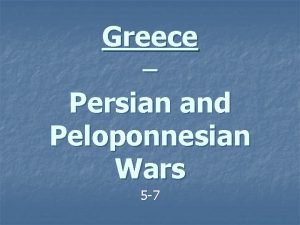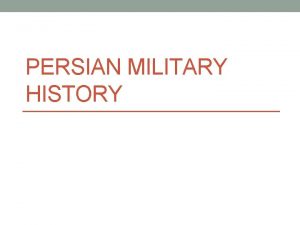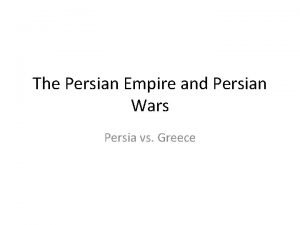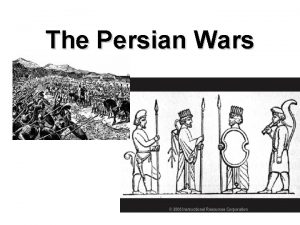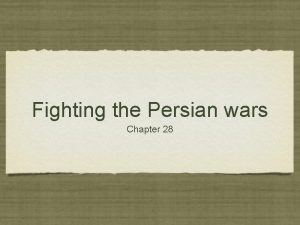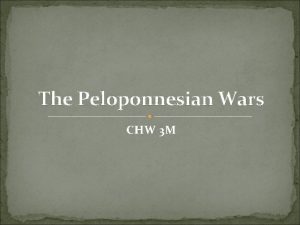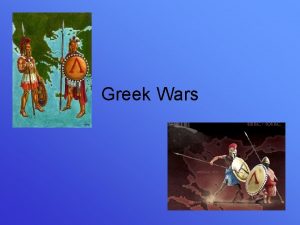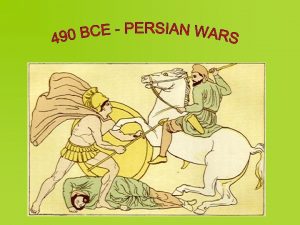Greek Military History The Persian Wars The Peloponnesian























































- Slides: 55

Greek Military History: The Persian Wars & The Peloponnesian Wars The Golden Age of Greece is set between two wars like giant bookends.

The Persian Wars I. Introduction 1. Series of military conflicts between Greek City-States & the Persian Empire in the 5 th Century B. C. E. 2. Outcome of wars shifted the balance of power from the Persians in the eastern Mediterranean to the Greeks & ushered a new era of Greek Civilization

The Persian Empire II. Background 1. Between 560 -500 B. C. E. great political changes took place in the eastern Mediterranean and the Near East 2. Persia & Cyrus the Great: 1. Expanded the Persian Empire to be the 2. largest empire the Near East had ever seen. Empire expanded to present day Pakistan in the east, the Balkan Peninsula in the west, from the Persian Gulf in the south, to Central Asia in the north


Development of Greek City-States II. Background 1. Many small city-states consisted of an urban center and surrounding territories on the Greek main lands and islands of the Aegean Sea 2. City-states mostly governed by local aristocracies 3. Athens—Democracy developed due to years of political reforms

Development of Greek City-States II. Background 1. Sparta 1. Strongest land power of all Greek citystates 2. Controlled alliance of Greek citystates that extended over southern Greece

III. The Persian Wars: The First Phase • Persian King Darius I – King of Persia, 521 -486 BC – Crushed resistance to his accession to the throne after a bloody (but brief) civil war – Reorganized the Persian Empire – Secured & expanded its borders Funerary Stele of King Darius I

III. The Persian Wars: The First Phase • Persian King Darius I – In 513 B. C. E. , Persians captured islands of Chios, Samos, and Lesbos – Crossed over to Europe & conquered area between Danube River & Aegean coast to borders of Macedonia • Historians argue that Darius I intended to conquer the whole of Greece & the whole region of the Aegean Sea Funerary Stele of King Darius I

III. The Persian Wars: The First Phase • The Invasion of Naxos (499 B. C. E. ) – First Step in plan to dominate central Aegean – Invasion Failed – Started a revolt of Ionian Greeks living on the coast of Asia Minor

III. The Persian Wars: The First Phase • The Ionian Revolt (499 -494 B. C. E. ) – Caused by Ionian’s dissatisfaction of economic & political conditions under the rule of the Persians – Ionians aided by Athens & Eretria (a city on the island of Euboea) who provided naval assistance – Persians defeated Ionians & subdued Ionian Revolt • Success Due to: winning decisive naval battles, and superior organization & numbers of soldiers/ships Athens Eretria (city on the island of Euboea) Ionian Greeks who revolted

III. The Persian Wars: The First Phase • Athens & Eretria v. the Persian Empire – Darius I convinced whole of Greece needed to be subdued in order to guarantee security of its empire in the west – In 492 B. C. E. Persian Empire launched an assault on Athens & Eretria in order to: • Gain control of the central Aegean • To punish Athens & Eretria for aiding the Ionians in their revolt against Persian control • First assault by the Persians Failed Persian fleet retreated after most of its ships were lost in a storm – In Summer of 490 B. C. E. Persians launched a second assault: • Persians capture Eretria & landed at Marathon • Marathon is about 25 miles north east of Athens • Athens failed to gain support from other Greek city-states, including Sparta and had to face the Persians themselves

III. The Persian Wars: The First Phase • The Battle of Marathon (490 B. C. E. ) – When the Persians landed, they were met by a small Athenian Army who easily defeated the Persian invaders. – They wanted Athens to know about the battle as soon as possible so they sent their fastest runner, Pheidippides to carry the message. – Legend has it that when he reached Athens he exclaimed, "Rejoice, we are victorious!" and then he fell down dead. – In the modern marathon today, a race of about 26 miles, is named in his memory and his run from Marathon. Pheidippides carries the message about the impending Persian invasion to Athens

III. The Persian Wars: The First Phase • The Battle of Marathon (490 B. C. E. ) – Athenian General Miltiades led Athenians with about 10, 000 Greek soldiers to defeat the Persians – Significance: showed superiority of heavier armored Greek solders over Persian opponents in close combat • Results of the Battle: – The Athenians defeated an overwhelming force of Persians – Athenian Casualties: 192 Men – Persian Casualties: 6. 400 – Incredible upset seeing not only were the Athenians outnumbered, but the Persian army was the best in the world at this time

IV. The Persian Wars: The Second Phase • Failure to capture Athens prompted Darius I to prepare a larger force of Persians for a second and final invasion – Invasion plans stalled by a rebellion in Egypt and other conflicts within the Persian Empire – Darius I died in 486 B. C. E. and was succeeded by his son, Xerxes I Funerary Stele of King Darius I

IV. The Persian Wars: The Second Phase • Xerxes I: – Accomplishments: • He reconquered Egypt • Amassed an enormous army of • about 200, 000 -300, 000 infantry soldiers and cavalry Amassed a navy of about 700 warships – Military Strategy to Defeat the Greeks: • Army & Navy cooperated to • ensure steady movement of supplies & troops Army provided bases while Navy provided transportation of troops & goods to bypass obstacles on land – 480 B. C. E. Xerxes I & military set sail for Greece and plan military campaign Marble or granite statue of King Xerxes I

The Persian Empire Under Xerxes I

Disunity of Greek City. States How could the absence of one “Greek” identity weaken the Greeks & hurt their chances to defeat the Persians?

IV. The Persian Wars: The Second Phase • Disunity Among Greek City-States: – City-states not united in attitude toward Persian invasion – Many Greek city-states believed it was hopeless to resist the Persians and surrendered to the Persian Empire – However, in 481 B. C. E a group of Greek city-states met to discuss fighting the Persians (they were not willing to give up) & made an alliance to fight the Persians • Greek Alliance: – May 480 B. C. E. Sparta was given command of land & sea military operations – Athens provided a majority of ships – The Alliance failed to hold off the Persian attack


IV. The Persian Wars: The Second Phase • Athenian & Spartan Defeat: The Battle of Thermopylae The Greeks launch a unified attack on the Persians by land & by sea (Artemisium)

IV. The Persian Wars: The Second Phase • Athenian & Spartan Defeat: The • • • Battle of Thermopylae (the “hot gates” was a pass that the Greeks tried unsuccessfully to defend in battle against the Persians led by Xerxes, in 480 B. C. Although the Spartans who led the defense were all killed, and may have known in advance that they would be, their courage provided inspiration to the Greeks. Spartan King Leonidas I was among those killed during battle Although the Spartans lost at Thermopylae, the following year the Greeks did win battles they fought against the Persians. Greeks who survived retreated King Leonidas (Gerald Butler) in The 300 (2007)

IV. The Persian Wars: The Second Phase • The Sacking of Athens: – Xerxes I conquered & occupied Athens – Greek fleet withdrew to the island of Salamis, which was an island close to Athens – Athens, Sparta, and other Greek city-states disagreed on what to do next. • Spartans & other Greek city-states advocated giving up & retreating • Athenians (under the leadership of Themistocles) opposed retreat & prepared to fight the Persians

IV. The Persian Wars: The Second Phase • The Battle of Salamis (480 B. C. E. ) – The Persians attacked the unified Greek navy – Persians and unified Greek force have about 378 warships

IV. The Persian Wars: The Second Phase • The Battle of Salamis (480 B. C. E. ) – Greek Strategy: • Greeks sail their ships into the narrow straits around the island of Salamis & scatter their ships to make the Persians think they are retreating – Persian Navy Loss Due to the Following: • Persian navy has difficulty navigating their ships around the narrow straits along the island of Salamis • The Persian navy is confused by the “retreating” Greek navy • The Greek navy rammed the Persians ships with their own because they were heavier than the Persian ships, thus destroying the Persian fleet

IV. The Persian Wars: The Second Phase • The Battle of Salamis (480 B. C. E. ) – Impact of Greek Victory at Salamis: • Destroyed hope of Persians continuing current military strategy of attacking the Greeks by land sea • Morale of Persian forces broken • Xerxes I returned home to Asia Minor – He was afraid the Ionians would engage in another revolt against the Persian Empire – He left his army, led by his general Mardonius, to deal with the Greeks

IV. The Persian Wars: The Second Phase • Mardonius’s Last Stand: – He tried to divide the Greeks by offering the Athenians amnesty (forgiveness) if they helped defeat the Spartans – Athenians refused to support Mardonius and he decided to fight the Greeks – In the Spring of 479 B. C. E. Mardonius recaptured Athens • He moved his forces north to Boeotia (present day central Greece) near the town of Plataea • Greeks and Persians (with roughly 110, 000 men each) fought for weeks, though the Greeks prevailed • Surviving Persians cut their losses, retreated, & returned home. • Greeks then launched an attack on the Persians empire in Asia Minor (present day Turkey)

V. The Legacy of the Persian Wars A. Greeks ended Persia’s expansion to the west and its control of the western coast of Asia minor (modern day Turkey) B. Athens & Sparta emerged as leading Greeks powers and dominated the Greek world C. Athens—became the dominant sea power & created a vast empire that stretched across the Aegean D. Developed a new sense of a Greek identity—Greek city-states developed their own identities & believed they were superior people E. Greek Culture became dominant in the Mediterranean F. Produced the first large-scale Greek historical work, The History, written by Herodotus. • The History was an account of the Persian Wars and their effect on Greek intellect & culture

The Peloponnesian Wars: 431 – 404 B. C. E I. Introduction 1. Military conflict in Ancient Greece that pitted Athens & its allies against Sparta and its allies

The Peloponnesian Wars: 431 – 404 B. C. E I. Introduction 1. The war was called the Peloponnesian War from the Athenian point of view, which implies it was a war against the Peloponnesians. 2. The war was called the Attic War from the Spartan point of view, that is a war against Athens, whose territory was called Attica.

The Peloponnesian Wars: 431 – 404 B. C. E I. Introduction The Spartans and many of their allies lived in the Peloponnesus, the southern half of Greece where Sparta’s influence was paramount (shown in Purple).

The Peloponnesian Wars: 431 – 404 B. C. E I. Introduction The Athenians and many of their allies lived in Attica, the eastern part of Greece, where the influence of Athens was paramount the (shown in Orange)

II. Background & Causes • The war was preceded by a conflict that took place from 460 -446 B. C. E. and was known as the First Peloponnesian War. – War was ended by the “Thirty Years Peace” – The terms of the peace agreement are unknown, but historian Thucydides argued the Second Peloponnesian War broke out for two main reasons: • Power & Fear • He argued that Athenian power instilled fear in the Spartans and compelled them to go to war.

II. Background & Causes Mainland Greece (in particular the Aegean Seaboard) • The war was fought in two main regions: Sic ily Mainland Greece (in particular the Aegean Seaboard)

II. Background & Causes • The Delian League: – The Athenian system of allies was known as the Delian League. – Formed in 5 th Century B. C. E. during the Persian Wars – Purpose: to defend Greek city-states along the Aegean Sea from Persian attack – The alliance was largely maritime: its members provided the Athenian navy with ships and/or troops – The Greek victory over the Persians enhanced the power & prestige of Athens. • After the war, members of the Delian League paid tribute to Athens in money rather than in ships or manpower

II. Background & Causes • Spartan Confederacy: – Spartan alliance system known as the Spartan Confederacy – Alliance was not tributary (like the Athenian network of allies), which was a serious Spartan weakness that often imposed distasteful political compromises – Corinth: • Most important of Spartan allies • Had a large naval fleet with a long standing naval tradition that was long-standing • Was a trading city-state that was a major rival of Athens

II. Background & Causes The Delian League (Athens & its Allies) and the Spartan Confederacy (Sparta & its Allies)

III. The Course of the War • The Archidamian War: – The first 10 years of the war – Named after the Spartan King Archidamus II • Original Purpose of the War: – Spartans claimed it was a war of “liberation” – The Greek city-states looked to the Spartans to free them from the “tyrant” city of Athens • The Athenians had amassed lots of material • resources due to having an empire in which city -states made tributes to them The Spartans, in order to achieve its objectives and claim success as liberators, had to put an end to the Athenian Empire. – Spartans failed to achieve their objectives by 421 B. C. E. so they said to have lost the first phase of the war.

III. The Course of the War • Early Battles: – Spartans led annual invasions of Attica • Invasions proved ineffective and did not produce real damage, though it led to a decrease in morale of the Athenians

III. The Course of the War • Pericles: – Athenian leader – Persuaded inhabitants of the countryside to abandon their land move to Athens – Turned Athens into a self-contained fortress Marble bust of Pericles

III. The Course of the War • Fortification of Athens: – Athens was supplied with food and other goods from its harbor at Piraeus A pair of long walls between Athens & Piraeus protected communications and the transportation of goods between the two.

III. The Course of the War • Fortification of Athens & the Death of Pericles: – The walled city of Athens could withstand a siege as long as its navy controlled the sea. – A plague, fueled by overcrowding in Athens, killed ¼ of the population in Athens in 430 B. C. E. • Pericles died in the plague & was succeeded by Cleon, a politician who had a reputation for violence and demagoguery— (manipulation of people by appealing to their emotions and prejudices) Marble bust of Pericles

III. The Course of the War • Failed Spartan Campaigns: – Mytilene (428 -427 B. C. E. ) • The Spartans tried to help the Mytileneans on the island of Lesbos in their revolt against Athenian domination • Spartans fought with little drive (halfheartedly) and delay & city-state of Mytilene was defeated by the Athenians Mytilene is a city-state on the island of Lesbos.

III. The Course of the War • Successful Spartan Campaign: – Plataea • The Spartans spent 4 years attacking & destroying Plataea, a city of pro-Athenian sentiment in southern Boeotia. • Athens did little to protect the Plataians against Spartan ruthlessness Plataea is a city-state in Attica.

III. The Course of the War • Failed Spartan City-State: – Herakleia • The Spartans founded a • new city-state of Herakleia in central Greece in (426 B. C. E) Herakleia failed because of the harsh and disreputable way the city-state was governed by its commanders – Significance—Spartan efforts at “liberation” from 431 -421 B. C. E. went badly because of acts of cruelty & savagery by individual Spartans Herakleia was a city-state in found in this island group.

III. The Course of the War • Successful Athenian Campaign & Major Athenian Defeat: – Battle of Pylos (425 B. C. E) • Athens won a naval • victory near Pylos on the western Peloponnese Athenians captured many elite Spartan soldiers – Victory was shortlived as they suffered from a major defeat by the Boeotians at the Battle of Delium (424 B. C. E. ) Athenian victory came at a battle near Pylos. The Athenians suffered a major defeat at the Battle of Delium.

III. The Course of the War • A Formal Peace is in Sight: – Battle between Spartan’s and Athenian’s in 422 B. C. E. – Two Leaders killed in Battle: • Brasidas—a new Spartan commander took charge of the Spartan military (combined military flair with charm and eloquence, which were two qualities that were not often found in Sparta. • Cleon—Aggressive Athenian leader – Mounting losses lead both sides to seek a formal peace – Spartans inclined to end the war because a peace treaty with their rivals at Argos was to expire & they did not have the resources or will to fight Argos.

IV. Peace of Nicias & Expedition to Sicily • An Unsteady Peace: – Nicias—an Athenian politician and general played a prominent role in the peace process • Helped negotiate the “Peace of Nicias” in 421 B. C. E. – The next three years marked political shuffling an a battle at Mantinea in 418 B. C. E. – Peace officially ended in 415 B. C. E. when Athenian politician and general Alcibiades decided to send a military expeditionary force against Sicily, an ally of Sparta

IV. Peace of Nicias & Expedition to Sicily • An Unsteady Peace: – Battle of Mantinea (418 B. C. E. ) – Sparta reasserted its military reputation by defeating its Athenian rivals Battle of Mantinea (418 B. C. E. )

IV. Peace of Nicias & Expedition to Sicily • An Unsteady Peace: – Battle of Syracuse (413 B. C. E. ) – The Athenian fleet was annihilated in a great sea battle of the Sicilian harbor, partly with the help of a Spartan commander, Gylippos Battle of Syracuse (413 B. C. E. )

V. The Final Phase • The Final Phase: – The remaining 9 years of the war are called the Ionian War because most of the fighting took place in the eastern Aegean, off the coast of Ionia (Modern Day western Turkey)

V. The Final Phase • The Final Phase: – The Athenians defeated the Spartans at Cyzicus in 410 B. C. E. and at Arguinusae in 406 B. C. E. – Neither Athens nor Sparta could force a decisive defeat one another Battle of Cyzicus Battle of Arguinusae

V. The Final Phase • The Final Phase: – Persian money and troops finally aided the Spartans to win a decisive victory at the Battle of Aegospotami under the command of the naval commander Lysander. Battle of Aegospotami

V. The Final Phase • Athens Surrenders: – Lysander then blockaded Piraeus – Hunger forced Athens to surrender to the leadership of Sparta. – Spartans imposed a short-lived government of 30 men known as the “Thirty Tyrants. ” – Rule was shortlived because of brutal tactics and Piraeus, the harbor town of Athens harsh ruling techniques, people revolted against their rule.

VI. Significance of the Peloponnesian War A. Following the war, Athens lost its empire, but the city-states it controlled did not gain their freedom. B. The Corinthian War (395 -386 B. C. E. ) broke out shortly after Athens was defeated • Coalition of Athenians, Persians, and former Spartan allies who were disillusioned by the domineering ways of the Spartans in the years after 404 B. C. E. all fought the Spartans C. In 378 B. C. E. Athens started a new naval confederacy modeled on the Delian League D. While the Greek city-states fought among themselves, Macedonia began building an empire in 359 B. C. E. E. In 338 B. C. E. the weakened Greek city-states fell and were defeated by the Macedonians

VI. Significance of the Peloponnesian War F. In 336 B. C. E. the city-states conquered by the Macedonians became part of the Macedonian empire of Alexander the Great. G. History—Athenian Thucydides wrote his book The History of the Peloponnesian War, which provides the history of the first 20 years of the war. • The book abruptly ends in 211 B. C. E. , but the rest of the information about the war and Greek history about this time period comes from Xenophon, as well as other writers such as Diodorus, Siculus, and Plutarch. Their information not only supplements, but also corrects come of Thucydides information.
 Persian wars end
Persian wars end Persian wars timeline
Persian wars timeline Ionian revolt timeline
Ionian revolt timeline Cyrus map
Cyrus map Persian wars timeline
Persian wars timeline Define persian wars
Define persian wars History alive chapter 28
History alive chapter 28 Persian wars
Persian wars Describe two effects of the persian wars
Describe two effects of the persian wars What were the causes and effects of the persian war
What were the causes and effects of the persian war The defining moment in greek history is the wars.
The defining moment in greek history is the wars. Peloponnesian war results
Peloponnesian war results The spread of hellenistic culture was aided by_____.
The spread of hellenistic culture was aided by_____. Golden age of pericles
Golden age of pericles Peloponnesian war
Peloponnesian war Thucydides the melian dialogue summary
Thucydides the melian dialogue summary 404 bce
404 bce Great peloponnesian war
Great peloponnesian war Star wars and greek mythology
Star wars and greek mythology The rise of the persian empire
The rise of the persian empire Nonius datus
Nonius datus Persian worship songs
Persian worship songs Qanat definition geography
Qanat definition geography Transitions for descriptive essays
Transitions for descriptive essays Iran map cat
Iran map cat Gregory is my beautiful gray persian cat
Gregory is my beautiful gray persian cat How did persian rulers unite their vast empire?
How did persian rulers unite their vast empire? The persian empire chapter 4 section 3
The persian empire chapter 4 section 3 Cambysus
Cambysus Royal road kabihasnan
Royal road kabihasnan Chapter 4 section 3 the persian empire
Chapter 4 section 3 the persian empire Persian empire trade routes
Persian empire trade routes Garamol
Garamol Persian chart
Persian chart Persian art
Persian art Persian royalty
Persian royalty Which major religion teaches conformity a caste system
Which major religion teaches conformity a caste system Chapter 4 section 3 the persian empire
Chapter 4 section 3 the persian empire Persian empire primary sources
Persian empire primary sources Persian religion before zoroastrianism
Persian religion before zoroastrianism Royal road in persia
Royal road in persia Persian
Persian Persian aqueducts
Persian aqueducts Persian gulf conflict
Persian gulf conflict Cause of persian war
Cause of persian war Persian empire golden age
Persian empire golden age What is the greek miracle in greek mythology
What is the greek miracle in greek mythology English georgian period flower arrangements
English georgian period flower arrangements Byzantine floral design flowers
Byzantine floral design flowers Greek drama origin
Greek drama origin Ancient greek masks
Ancient greek masks Greek fire definition ap world history
Greek fire definition ap world history History of drama
History of drama Greek history
Greek history “people are cesspools of hidden desires”
“people are cesspools of hidden desires” Unit 7 the world between the wars
Unit 7 the world between the wars


